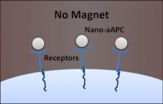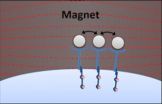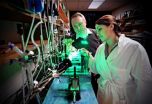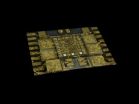(Press-News.org) Using tiny particles designed to target cancer-fighting immune cells, Johns Hopkins researchers have trained the immune systems of mice to fight melanoma, a deadly skin cancer. The experiments, described on the website of ACS Nano on February 24, represent a significant step toward using nanoparticles and magnetism to treat a variety of conditions, the researchers say.
"Size was key to this experiment," says Jonathan Schneck, M.D., Ph.D., a professor of pathology, medicine and oncology at the Johns Hopkins University School of Medicine's Institute for Cell Engineering. "By using small enough particles, we could, for the first time, see a key difference in cancer-fighting cells, and we harnessed that knowledge to enhance the immune attack on cancer."
Schneck's team has pioneered the development of artificial white blood cells, so-called artificial antigen-presenting cells (aAPCs), which show promise in training animals' immune systems to fight diseases such as cancer. To do that, the aAPCs must interact with immune cells known as naive T cells that are already present in the body, awaiting instructions about which specific invader they will battle. The aAPCs bind to specialized receptors on the T cells' surfaces and "presenting" them with distinctive proteins called antigens. This process activates the T cells, programming them to battle a specific threat such as a virus, bacteria or tumor, as well as to make more T cells.
The team had been working with microscale particles, which are about one-hundredth of a millimeter across. But, says Schneck, aAPCs of that size are still too large to get into some areas of a body and may even cause tissue damage because of their relatively large size. In addition, the microscale particles bound equally well to naive T cells and others, so the team began to explore using much smaller nanoscale aAPCs. Since size and shape are central to how aAPCs interact with T cells, Karlo Perica, a graduate student in Schneck's laboratory, tested the impact of these smaller particles.
The so-called nano-aAPCs were small enough that many of them could bind to a single T cell, as the team had expected. But when Perica compared naive T cells to those that had been activated, he found that the naive cells were able to bind more nanoparticles. "This was quite surprising, since many studies had already shown that naive and activated T cells had equal numbers of receptors," Schneck says. "Based on Karlo's results, we suspected that the activated cells' receptors were configured in a way that limited the number of nanoparticles that could bind to them."
To see whether there indeed was a relationship between activation and receptor clustering, Perica applied a magnetic field to the cells, causing the nano-aAPCs to attract one another and cluster together, bringing the receptors with them. The clustering did indeed activate the naive T cells, and it made the activated cells even more active — effectively ramping up the normal immune response.
To examine how the increased activation would play out in living animals, the team treated a sample of T cells with nano-aAPCs targeting those T cells programmed to battle melanoma. The researchers next put the treated cells under a magnetic field and then put them into mice with skin tumors. The tumors in mice treated with both nano-aAPCs and magnetism stopped growing, and by the end of the experiment, they were about 10 times smaller than those of untreated mice, the researchers found. In addition, they report, six of the eight magnetism-treated mice survived for more than four weeks showing no signs of tumor growth, compared to zero of the untreated mice.
"We were able to fine-tune the strength of the immune response by varying the strength of the magnetic field and how long it was applied, much as different doses of a drug yield different effects," says Perica. "We think this is the first time magnetic fields have acted like medicine in this way."
In addition to its potential medical applications, Perica notes that combining nanoparticles and magnetism may give researchers a new window into fundamental biological processes. "In my field, immunology, a major puzzle is how T cells pick out the antigen they're targeting in a sea of similar antigens in order to find and destroy a specific threat," he says. "Receptors are key to that action, and the nano-aAPCs let us detect what the receptors are doing."
"We have a bevy of new questions to work on now: What's the optimal magnetic 'dose'? Could we use magnetic fields to activate T cells without taking them out of the body? And could magnets be used to target an immune response to a particular part of the body, such as a tumor's location?" Schneck adds. "We're excited to see where this new avenue of research takes us."
INFORMATION:
Other authors on the report are Ang Tu, Joan Bieler and Michael Edidin of the Johns Hopkins University School of Medicine, and Anne Richter of Miltenyi Biotec.
This work was supported by the National Institute of Allergy and Infectious Diseases (grant numbers P01-AI072677 and R01-AI44129), the National Cancer Institute (grant number R01-CA108835), Miltenyi Biotec and the Cancer Research Institute.
Under a licensing agreement between NexImmune and the Johns Hopkins University, Jonathan Schneck is entitled to a share of royalty received by the University on sales of products described in this publication. Schneck also owns NexImmune stock, which is subject to certain restrictions under University policy. He is also a member of the company's Board of Directors and Scientific Advisory Board. The terms of this arrangement are being managed by the Johns Hopkins University in accordance with its conflict of interest policies.
ACS Nano article: http://pubs.acs.org/doi/full/10.1021/nn405520d
Magnetic medicine
Nanoparticles and magnetic fields train immune cells to fight cancer in mice
2014-02-25
ELSE PRESS RELEASES FROM THIS DATE:
3-D printer creates transformative device for heart treatment
2014-02-25
Igor Efimov, PhD, at the School of Engineering & Applied Science at Washington University in St. Louis and an international team of biomedical engineers and materials scientists have created a 3-D elastic membrane made of a soft, flexible, silicon material that is precisely shaped to match the heart's epicardium, or the outer layer of the wall of the heart. Current technology is two-dimensional and cannot cover the full surface of the epicardium or maintain reliable contact for continual use without sutures or adhesives.
The team can then print tiny sensors onto the membrane ...
Vitamin A may help boost immune system to fight tuberculosis
2014-02-25
Tuberculosis is a major global problem, affecting 2 billion people worldwide and causing an estimated 2 million deaths annually. Western countries are once again tackling the disease, with recent outbreaks in Los Angeles and London.
The rise of drug-resistant TB, called a "ticking time bomb" by the World Health Organization, and the high cost of fighting the disease highlight the need for new approaches to treatment.
In findings published in the March 1 issue of the Journal of Immunology, UCLA researchers investigating the role of nutrients in helping the immune ...
Discovery of a 'conductor' in muscle development
2014-02-25
Montréal, February 25, 2014 – A team led by Jean-François Côté, researcher at the IRCM, identified a ''conductor'' in the development of muscle tissue. The discovery, published online yesterday by the scientific journal Proceedings of the National Academy of Sciences (PNAS), could have an important impact on the treatment of muscular diseases such as myopathies and muscular dystrophies.
"For several years, we have been studying myogenesis, a process by which muscles are formed during embryonic development," says Jean-François Côté, PhD, Director of the Cytoskeletal Organization ...
Psychological side-effects of anti-depressants worse than thought
2014-02-25
LIVERPOOL, UK – 26 February 2014: A University of Liverpool researcher has shown that thoughts of suicide, sexual difficulties and emotional numbness as a result of anti-depressants may be more widespread than previously thought.
In a survey of 1,829 people who had been prescribed anti-depressants, the researchers found large numbers of people – over half in some cases – reporting on psychological problems due to their medication, which has led to growing concerns about the scale of the problem of over-prescription of these drugs.
Psychologist and lead researcher, Professor ...
New record set for data-transfer speeds
2014-02-25
WASHINGTON, Feb. 25, 2014 – Researchers at IBM have set a new record for data transmission over a multimode optical fiber, a type of cable that is typically used to connect nearby computers within a single building or on a campus. The achievement demonstrated that the standard, existing technology for sending data over short distances should be able to meet the growing needs of servers, data centers and supercomputers through the end of this decade, the researchers said.
Sending data at a rate of 64 gigabits per second (Gb/s) over a cable 57 meters long using a type ...
NHS Scotland reduces post-code lottery for hip replacement surgery
2014-02-25
Tuesday 25 February – A reduction in the post-code lottery for hip replacement surgery has been achieved in Scotland without recourse to the private sector, according to new research published in the Journal of the Royal Society of Medicine. Using NHS Scotland data, researchers at the Centre for Primary Care and Public Health at Queen Mary University of London with colleagues from the University of Edinburgh and Lothian University Hospitals NHS Trust, show that access to hip replacement increased and geographical inequalities improved across all geographical health boards ...
Researchers generate new neurons in brains, spinal cords of living adult mammals
2014-02-25
DALLAS, Feb. 25, 2014 – UT Southwestern Medical Center researchers created new nerve cells in the brains and spinal cords of living mammals without the need for stem cell transplants to replenish lost cells.
Although the research indicates it may someday be possible to regenerate neurons from the body's own cells to repair traumatic brain injury or spinal cord damage or to treat conditions such as Alzheimer's disease, the researchers stressed that it is too soon to know whether the neurons created in these initial studies resulted in any functional improvements, a goal ...
Does solitary confinement fuel more crime?
2014-02-25
EAST LANSING, Mich. — Solitary confinement does not make supermax prison inmates more likely to re-offend once they're released, finds a study on the controversial penitentiaries led by a Michigan State University criminologist.
The study – one of the first to examine recidivism rates among supermax inmates – refute critics' claims that serving extended time in isolation leads to more crime. Super-maximum security units, known as supermax units or prisons within prisons, are designed to house problematic inmates by keeping them isolated for as long as 23 hours a day.
Jesenia ...
Small start-up businesses in rural areas must hustle for loans from far-off banks
2014-02-25
To better their survival chances, entrepreneurs and owners of small businesses in rural areas must successfully pitch their ventures to "faraway, unknown banking officials" rather than relying on local lenders as in the past, according to Baylor University researchers.
Increasingly, bank branches are headquartered in distant urban areas – and in some cases, financial "deserts" exist in towns with few or no traditional financial institutions such as banks and credit unions. That means that local lending to individuals based on "relational" banking — with lenders being aware ...
New risk gene illuminates Alzheimer's disease
2014-02-25
A team of international scientists, including a researcher from Simon Fraser University, has isolated a gene thought to play a causal role in the development of Alzheimer's disease. The Proceedings of the National Academy of Sciences recently published the team's study.
The newly identified gene affects accumulation of amyloid-beta, a protein believed to be one of the main causes of the damage that underpins this brain disease in humans.
The gene encodes a protein that is important for intracellular transportation. Each brain cell relies on an internal highway system ...
LAST 30 PRESS RELEASES:
School meals could unlock major gains for human and planetary health
Menopause hormone therapy does not appear to impact dementia risk
Signature patterns of brain activity may help predict recovery from traumatic brain injury
Dresden study uncovers new key mechanism in cancer cells
New species are now being discovered faster than ever before, study suggests
Cannabis-based products show limited short-term benefit for chronic pain, with increased risk of adverse effects
Cannabis products with more THC slightly reduce pain but cause more side effects
Clearing the brain of aging cells could aid epilepsy and reduce seizures
Brain injuries linked with potential risk of suicide, new study finds
New technique lights up where drugs go in the body, cell by cell
New study finds movement of fishing fleets can reveal shifts in marine ecosystems
Embargoed: New evidence points to potential treatment for vascular dementia
Study uncovers disrupted brain balance in alcohol dependence
Working in groups can help Republicans and Democrats agree on controversial content moderation online
Structural findings reveal how distinct GPCR ligands create different levels of activation
Anything-goes “anyons” may be at the root of surprising quantum experiments
UC review: Maximizing workplace opportunity for veterans
From generation to complex control: Metasurfaces make perfect vortex beams "within reach"
Thin-film lithium niobate-based detector: recent advances and perspectives
Exploring why some people may tend to persistently make bad choices
How cells balance their protein levels
Nirsevimab vs RSVpreF vaccine for RSV–related hospitalization in newborns
Effectiveness and impact of maternal RSV immunization and nirsevimab on medically attended RSV in US children
AI gives scientists a boost, but at the cost of too many mediocre papers
Next-generation vision model maps tree growth at sub-meter precision
Genes aren’t destiny for inherited blindness, study shows
MIT study: High-fat diets make liver cells more likely to become cancerous
Exposure to multiple fine particulate matter components and incident depression in the US Medicare population
Risk of burdensome health care spending over time in the US
Nirsevimab against hospitalizations and emergency department visits for lower respiratory tract infection in infants
[Press-News.org] Magnetic medicineNanoparticles and magnetic fields train immune cells to fight cancer in mice





